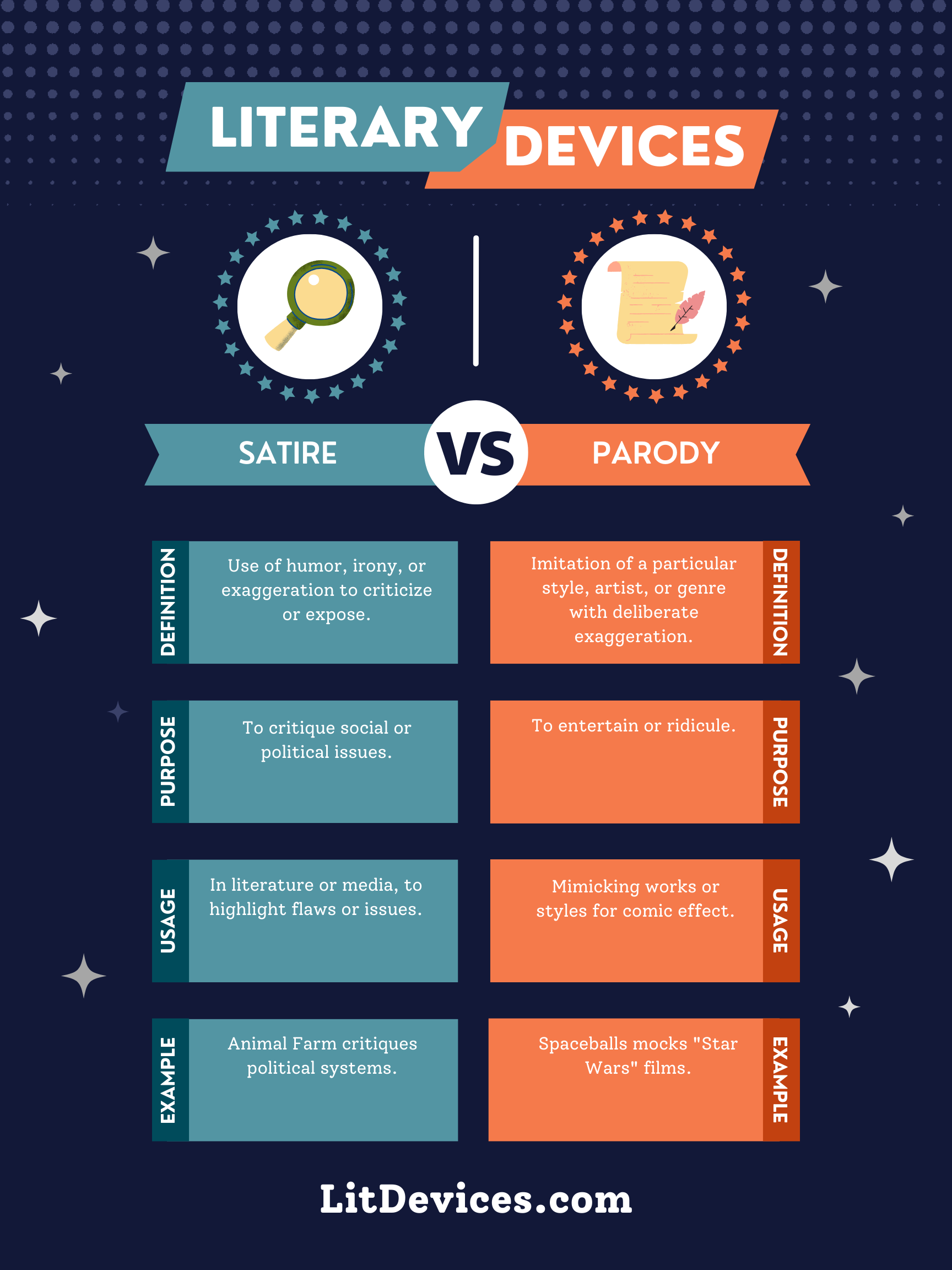Parody imitates the style of a particular genre, work, or author for comedic effect, often exaggerating it; Satire uses humor, irony, exaggeration, or ridicule to expose and criticize people’s stupidity or vices, particularly in the context of contemporary politics and other topical issues.
Parody and satire are potent tools in the arsenal of literary devices, each serving to illuminate and entertain through humor. Let’s explore these engaging styles. 😄🎭
Parody
Parody humorously imitates another work or style to ridicule or comment on the original’s characteristics, often by amplifying its features to the point of absurdity. “Don Quixote” by Miguel de Cervantes can be seen as a parody of the romantic chivalric traditions prevalent in literature of its time.
Satire
Satire goes beyond mere imitation to offer criticism and commentary on society, politics, and human nature. It seeks to provoke change by highlighting flaws and vices. Jonathan Swift’s “A Modest Proposal” is a seminal example, using exaggerated irony to critique the treatment of the poor in 18th-century Ireland.
Summary
| Literary Device | Definition | Purpose | Usage | Relevant Examples |
|---|---|---|---|---|
| Parody | Imitates the style of a genre, work, or author for comedic effect. | To entertain by highlighting the absurdities of the original. | Literature, film, music, television. | “Don Quixote” by Miguel de Cervantes. |
| Satire | Uses humor, irony, and exaggeration to criticize people’s stupidity or vices. | To provoke thought and encourage reform by critiquing society. | Literature, journalism, television. | “A Modest Proposal” by Jonathan Swift. |
Writing Tips
For Parody:
- Know Your Target: Understand the original work or style thoroughly to effectively mimic and exaggerate its features.
- Balance Imitation with Innovation: While mirroring the original, introduce unique comedic elements to make your parody stand out.
- Emphasize the Absurd: Exaggerate aspects of the original to create humor and highlight its inherent absurdities.
For Satire:
- Sharpen Your Wit: Use clever and cutting humor to make your critique impactful.
- Be Topical: Satire resonates most when it addresses current societal issues, politics, or human behaviors.
- Aim for Reform: Your satire should not only criticize but also suggest the need for change or highlight the folly of the status quo.
FAQs
Can a work be both a parody and satire?
Yes, many works blend parody and satire, using the imitation of parody to deliver the critical commentary of satire.
How do audiences typically react to parody vs satire?
While both aim to entertain, parody is often received with light-hearted amusement, whereas satire may provoke deeper reflection, discomfort, or even controversy due to its critical nature.
Exercise
Read the following excerpt: “In the land of Excessia, where the rivers flowed with soda and the mountains were made of sugar, the great King Glutton feasted while his people starved.”
Answer: This passage employs elements of satire, using exaggerated and ironic descriptions to critique excess and negligence.
Other Interesting Literary Device Comparisons
- Irony vs Sarcasm: Irony involves saying one thing but meaning another, often subtly, whereas sarcasm is a form of verbal irony used to mock or convey contempt more directly.
- Allegory vs Symbolism: Allegory is a narrative in which characters and events symbolize deeper truths or generalizations about human existence, while symbolism involves the use of symbols to represent ideas or qualities in a more isolated manner.
- Hyperbole vs Understatement: Hyperbole exaggerates for effect, while understatement minimizes the importance of what is being described, often for ironic or humorous effect.
Diving into these literary devices enriches our understanding of storytelling, revealing the intricate layers through which writers can entertain, critique, and provoke thought. 📚🔍

